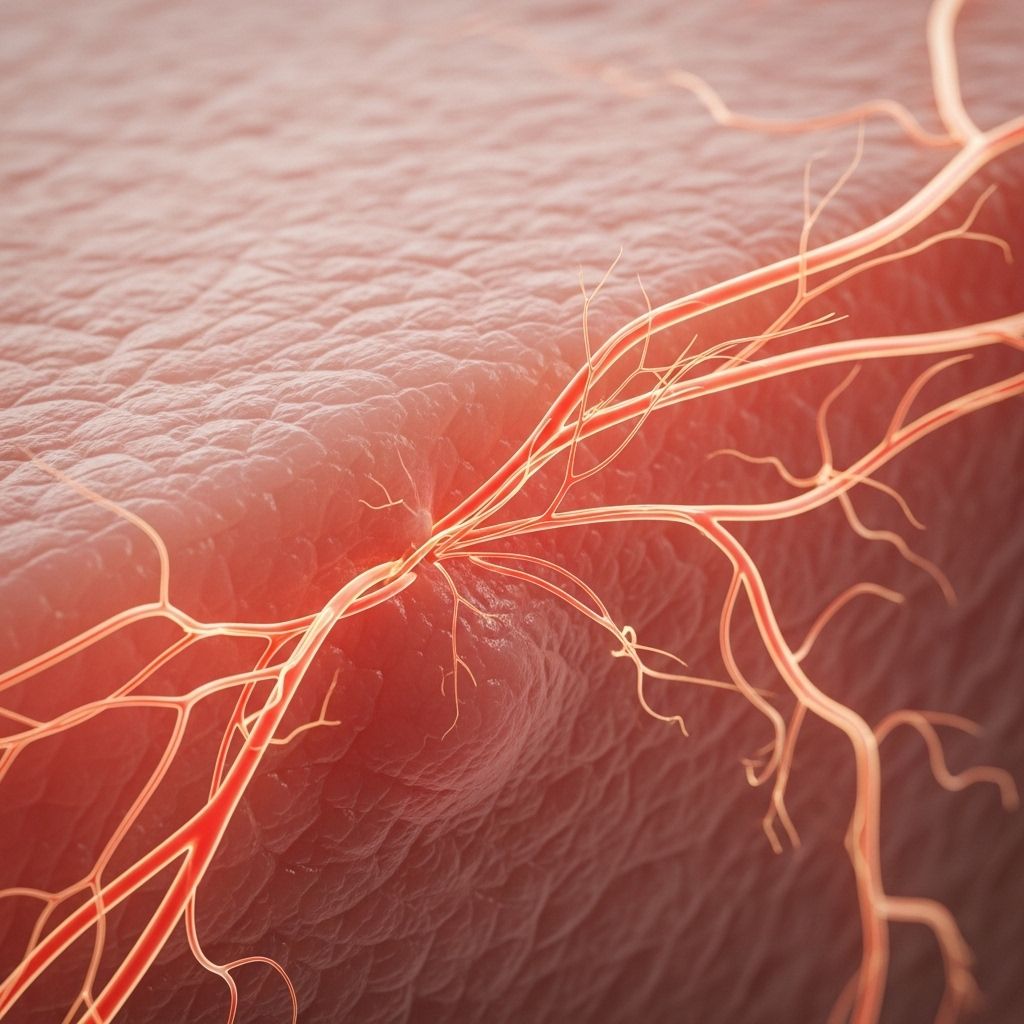Blood Flow & Acne: Boosting Healing Without Inflammation
Vascular delivery speeds acne lesion repair while preventing excess inflammation.

Table of Contents
- Introduction
- Acne and Inflammation
- Blood Flow and Skin Health
- Effect of Blood Flow on Acne Healing
- Strategies to Improve Blood Flow for Acne Healing
- Frequently Asked Questions
Introduction
Acne, a common skin condition, often leads to inflammation and scarring, affecting millions worldwide. The process of acne involves complex interactions between the skin’s microenvironment and the body’s overall health, including blood flow. Blood circulation plays a vital role in maintaining skin health by delivering oxygen and nutrients while removing waste products. This article explores the relationship between blood flow and acne healing, discussing how improved circulation can enhance recovery without exacerbating inflammation.
Acne and Inflammation
Acne is primarily an inflammatory condition, with lesions often resulting from blocked pores and bacterial infections. Inflammation in acne can lead to scarring and prolonged healing times. Understanding the inflammatory process is crucial for developing effective treatments that minimize damage and promote healing.
Research has shown that during the inflammatory stages of acne, blood flow and microcirculation are altered. There is increased vascular density in the affected areas, which can both contribute to and be a result of the inflammation process. Managing inflammation is key to preventing scarring and achieving swift recovery.
Blood Flow and Skin Health
Blood flow is essential for maintaining optimal skin health. It ensures the delivery of oxygen, nutrients, and the removal of waste products, which are vital for skin cell vitality and resilience. Enhanced blood flow promotes collagen production, regulates skin temperature, and supports wound healing by facilitating the supply of necessary nutrients and factors for tissue repair.
Benefits of Improved Blood Flow:
- Enhanced Oxygen Delivery: Increased blood flow ensures that skin cells receive adequate oxygen, supporting cellular metabolism and energy production.
- Increased Nutrient Delivery: Optimal blood flow delivers essential nutrients, such as vitamins and amino acids, necessary for collagen synthesis and skin repair.
- Accelerated Waste Removal: Efficient circulation helps remove metabolic waste and toxins, preventing skin congestion and inflammation.
Effect of Blood Flow on Acne Healing
Blood flow significantly impacts the healing process of acne lesions. Increased blood perfusion in acne lesions is associated with enhanced wound healing and the chemotaxis of inflammatory cells, which can both aid and exacerbate the healing process. While blood flow is crucial for delivering nutrients and removing waste, excessive inflammation must be managed to prevent scarring.
Strategies to Improve Blood Flow for Acne Healing
Several strategies can enhance blood flow to the skin, promoting acne healing without increasing inflammation:
Physical Activity:
Regular physical activity stimulates the muscle pump, which aids in increasing blood circulation. This can be especially beneficial for improving blood flow to the face through mechanisms like anastomoses, which are natural bypasses in the circulatory system.
Massage Therapy:
Massage can help open anastomoses, improving blood flow and facilitating the delivery of oxygen and nutrients to affected areas, thereby enhancing healing.
Facial Exercises:
Engaging in facial exercises can increase blood flow and stimulate collagen production, contributing to healthier skin and potentially aiding in the healing of acne scars.
Red Light Therapy:
Red light therapy has been shown to improve skin appearance by increasing collagen production and reducing inflammation, making it a potential treatment for acne scars.
Frequently Asked Questions
Q: How does blood flow affect acne healing?
A: Blood flow plays a crucial role in acne healing by delivering oxygen and nutrients to the affected areas while removing waste products. However, excessive inflammation should be managed to prevent scarring.
Q: What are some ways to improve blood flow for acne healing?
A: Strategies to improve blood flow include physical activity, massage therapy, facial exercises, and medical treatments like red light therapy.
Q: Can blood flow be too high in acne healing?
A: While blood flow is essential for healing, excessive inflammation can be detrimental. Managing inflammation is key to effective healing without scarring.
Conclusion
Blood flow is a critical factor in acne healing, offering both benefits and challenges. By understanding the role of circulation in skin health and implementing strategies to optimize blood flow, individuals can enhance their acne healing process without exacerbating inflammation. This approach not only supports the recovery from acne but also contributes to overall skin health.
References
- https://pmc.ncbi.nlm.nih.gov/articles/PMC4376563/
- https://www.clinikally.com/blogs/news/skin-circulation-benefits
- https://viaskincare.com/understanding-the-complex-mechanisms-of-blood-flow-in-the-face-and-neck/
- https://onlinelibrary.wiley.com/doi/10.1111/jocd.15811
- https://my.clevelandclinic.org/health/articles/22114-red-light-therapy
- https://www.marieveronique.com/blogs/science-research/does-great-skin-start-in-the-blood-the-role-of-circulation-in-skin-health
- https://www.dulyhealthandcare.com/health-topic/what-is-high-frequency-and-why-do-we-use-it
- https://www.foreo.com/mysa/how-does-blood-flow-affect-your-skin
- https://www.uspharmacist.com/article/preventing-and-treating-acne
Read full bio of Sneha Tete












